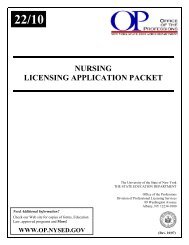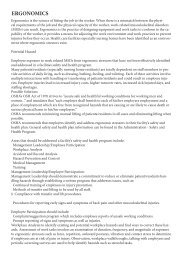TB Infection Control - Healthsource Global!
TB Infection Control - Healthsource Global!
TB Infection Control - Healthsource Global!
Create successful ePaper yourself
Turn your PDF publications into a flip-book with our unique Google optimized e-Paper software.
Use of respiratory protection equipment can further<br />
reduce risk for exposure of HCWs to infectious droplet<br />
nuclei that have been expelled into the air from a patient<br />
with infectious <strong>TB</strong> disease. The following measures can<br />
be taken to reduce the risk for exposure:<br />
• Implementing a respiratory protection program<br />
• Training HCWs on respiratory protection<br />
• Training patients on respiratory hygiene and cough<br />
etiquette procedures.<br />
Determining the Infectiousness<br />
of <strong>TB</strong> Patients<br />
In general, patients who have suspected or confirmed<br />
<strong>TB</strong> disease should be considered infectious if (a) they<br />
are coughing, undergoing cough-inducing procedures,<br />
or have positive sputum smear results for acid-fast<br />
bacilli (AFB); and (b) they are not receiving adequate<br />
antituberculosis therapy, have just started therapy, or<br />
have a poor clinical or bacteriologic response to therapy.<br />
For patients placed under airborne precautions because<br />
of suspected infectious <strong>TB</strong> disease of the lungs, airway,<br />
or larynx, airborne precautions can be discontinued when<br />
infectious <strong>TB</strong> disease is considered unlikely and either<br />
• Another diagnosis is made that explains the clinical<br />
syndrome, or<br />
• The patient produces three consecutive negative<br />
sputum smears collected in 8- to 24-hour intervals<br />
(one should be an early morning specimen).<br />
Patients for whom the suspicion of infectious <strong>TB</strong> disease<br />
remains after the collection of three negative sputum<br />
smear results should not be released from airborne<br />
precautions until they<br />
• Receive standard multidrug antituberculosis<br />
treatment (minimum of 2 weeks) and<br />
• Demonstrate clinical improvement.<br />
For these patients, additional diagnostic approaches<br />
(e.g., sputum induction) and, after sufficient time on<br />
treatment, bronchoscopy may need to be considered.<br />
Patients who have drug-susceptible <strong>TB</strong> of the lung,<br />
airway, or larynx, should remain under airborne<br />
precautions until they<br />
• Produce three consecutive negative sputum smears<br />
collected in 8- to 24-hour intervals (one should be an<br />
early morning specimen), and<br />
• Receive standard multidrug antituberculosis<br />
treatment (minimum of 2 weeks), and<br />
• Demonstrate clinical improvement.<br />
Note<br />
The Centers for Disease <strong>Control</strong> and Prevention (CDC)<br />
is not a regulatory agency; CDC recommendations on<br />
infection control provide evidence-based guidance.<br />
For regulations in your area, refer to state and local<br />
regulations and contact your local Occupational Safety<br />
and Health Administration (OSHA) office. A directory of<br />
OSHA offices may be found at www.osha-slc.gov/html/<br />
RAmap.html.<br />
References<br />
CDC. Guidelines for preventing the transmission of<br />
Mycobacterium tuberculosis in health-care settings,<br />
2005. MMWR 2005; 54(No. RR-17).<br />
www.cdc.gov/mmwr/pdf/rr/rr5417.pdf<br />
Additional Information<br />
Websites:<br />
CDC Division of Tuberculosis Elimination:<br />
www.cdc.gov/tb<br />
State <strong>TB</strong> control offices:<br />
www.cdc.gov/tb/links/tboffices.htm<br />
National Institute for Occupational Safety and Health:<br />
www.cdc.gov/niosh/topics/tb<br />
Occupational Safety and Health Administration:<br />
www.osha.gov/SLTC/tuberculosis/<br />
Fact Sheet:<br />
Respiratory Protection in Health-Care Settings:<br />
www.cdc.gov/tb/publications/factsheets/prevention/<br />
rphcs.htm<br />
April 2010 www.cdc.gov/tb Page 2 of 2<br />
Safer . Healthier . People








